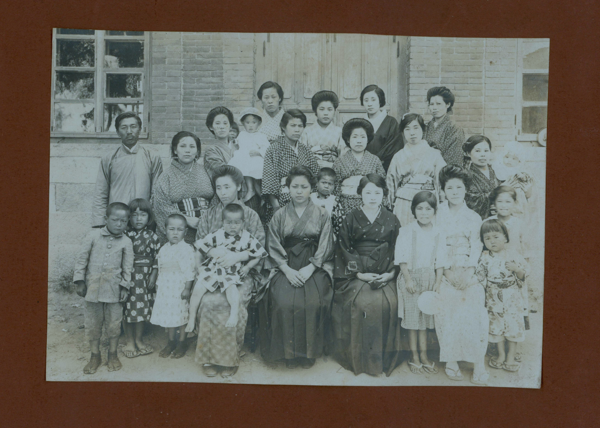Title: Photograph album of a Japanese family in Manchuria, colonial Korea, and Japan
Year: 1920/1922
Location: Manchuria (China, Asia) (general region)
I choose a photograph album of a Japanese family in Manchuria, colonial Korea, and Japan. A photograph album of a Japanese family in Manchuria, colonial Korea, and Japan offer valuable insights into the social and cultural dynamics of the early 20th century in East Asia. The photographs provide evidence of the family’s lifestyle, customs, and attitudes towards colonialism. The first photograph as we can see is a big picture of a family from this picture I notice that in the past a lot of people had many kids and in some countries they also had many wives for example in Thailand in the past they have a lot of kids for example my grandfather family they had eight or nine people in the family. As I research I found that “They needed children to work on the farm. Kids were labor. In a rural economy, it pays to have children; in an urban economy, it costs to have children. Infant and childhood mortality was higher at that time, so people had more children to ensure that some would live until adulthood.” (Johns) So I think this is one of the main reasons why people have so many kids in the past. I found this image very interesting because the pictures show the culture and the lifestyle of people in the past and it made me want to learn more about it and find out more about what is the real meaning of the picture.
In Manchuria, the family has been part of the Japanese military occupation force or civilian settlers who moved there to exploit its resources. Photographs of them interacting with Chinese locals, conducting business, or participating in cultural events may offer clues to the family’s social standing and relationship with the local population.
In colonial Korea, the family might have lived in one of the urban centers, such as Seoul or Busan, or in a rural area where they owned land or managed a farm. Photographs of the family’s interactions with Korean neighbors, servants, or employees may reveal the power dynamics of colonialism and the impact of Japanese culture on Korean society.
In Japan, the photographs may depict the family’s lifestyle, education, and leisure
activities, such as tea ceremonies, flower arranging, or martial arts. The photographs also provide evidence of the family’s attitudes toward Japanese imperialism, militarism, and nationalism. I think the photographs may reveal information about the family’s status, occupation, and lifestyle, as well as their interactions with other people and cultures in the region. They may also provide insight into the broader historical context of colonialism, imperialism, and militarism in East Asia during the early 20th century. I think the future of a location is shaped by numerous factors, including economic, political, and social conditions, as well as natural events and technological advancements. For example: as in the picture we can see that they wear Japanese natural clothing which is called “kimono”. “The first ancestor of the kimono was born in the Heian period (794-1192). Straight cuts of fabric were sewn together to create a garment that fit every sort of body shape. It was easy to wear and infinitely adaptable. By the Edo period (1603-1868) it had evolved into a unisex outer garment called kosode.” (Green) It represents the culture in Japanese so it may provide valuable historical context.
The meaning of the image for the photographer is he or she might use their own family’s experiences, to capture a record of life in a particular place and time. In my opinion, the meaning of the image for the local people/place being depicted would depend on the specific image and the context in which it was taken. Some images may have been seen as positive or celebratory by the local people, while others may have been viewed as exploitative or oppressive. For example, if the photograph shows the Japanese family interacting positively with the local people, it may have been seen as a representation of cultural exchange and harmony. “In Japanese culture, communication styles reflect on maintaining harmony. The Japanese are generally non-confrontational and rarely directly give negative responses such as insults, criticisms, or cause embarrassment to anyone. To present something disagreeable, Japanese usually will do so using indirect communication.” (Yasuka). Alternatively, if the photograph shows the Japanese family in a position of power over the local people, it may have been viewed as a symbol of colonialism and domination. The historical meaning of the image would depend on the context of the time and the broader historical events that were taking place. For example, during the period of Japanese imperial expansion in East Asia, photographs of Japanese families in colonial territories may have been used to promote the idea of Japanese superiority and justify their control over these territories. In contrast, in the aftermath of World War II and Japan’s defeat, such images may have been viewed as evidence of Japanese imperialism and the harm it caused to other nations and peoples.
In conclusion, the photographs offer valuable insights into the social and cultural dynamics of the time, including the family’s lifestyle, customs, and attitudes toward colonialism. The photographs provide evidence of the family’s status, occupation, and lifestyle, as well as their interactions with other people and cultures in the region. The meaning of the image for the photographer would be capturing a record of life in a particular place and time, while the meaning for the local people/place being depicted would depend on the specific image and context. The historical meaning of the image would depend on the context of the time and the broader historical events taking place. I think it is a very interesting album that shows how the culture or the lifestyles of Japanese people in the past.
